Holmes Institute Retail: Changing Face of Retailing in Australia
VerifiedAdded on 2023/01/03
|11
|2271
|1
Report
AI Summary
This report provides a comprehensive analysis of the evolving retail landscape in Australia. It begins with an executive summary, followed by an introduction defining retailing and its significance in the Australian economy. The report then explores the major changes and developments in the Australian retail system, emphasizing the impact of online shopping and the shift from physical stores to e-commerce. Key drivers of retail format changes, such as convenience, internet access, and mobile communication, are examined. Furthermore, the report discusses the future of retailing in Australia, including the rise of mobile retail and multichannel strategies. The analysis includes a discussion of alternative retail store options, concluding with a summary of the findings and a reference list supporting the research.
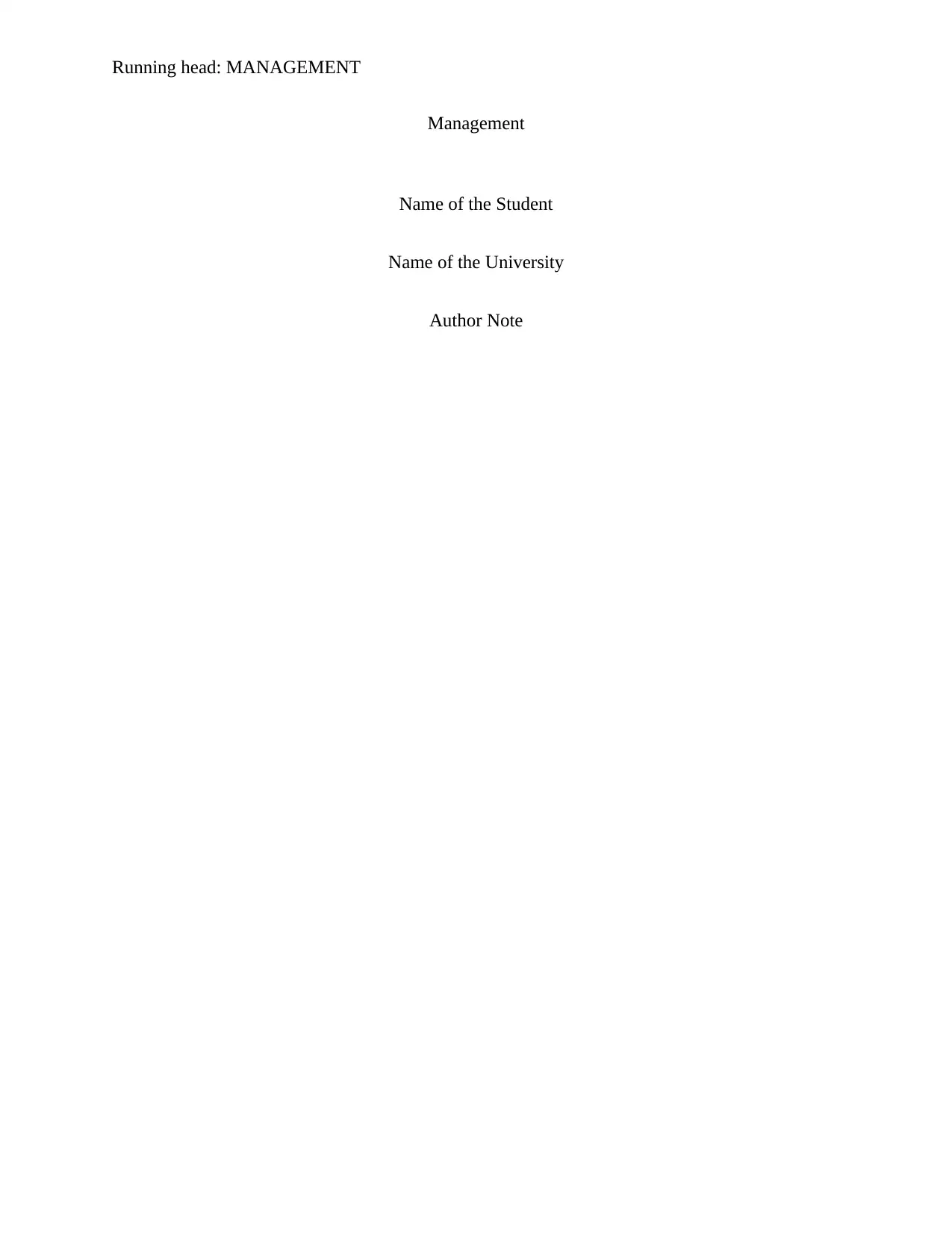
Running head: MANAGEMENT
Management
Name of the Student
Name of the University
Author Note
Management
Name of the Student
Name of the University
Author Note
Paraphrase This Document
Need a fresh take? Get an instant paraphrase of this document with our AI Paraphraser
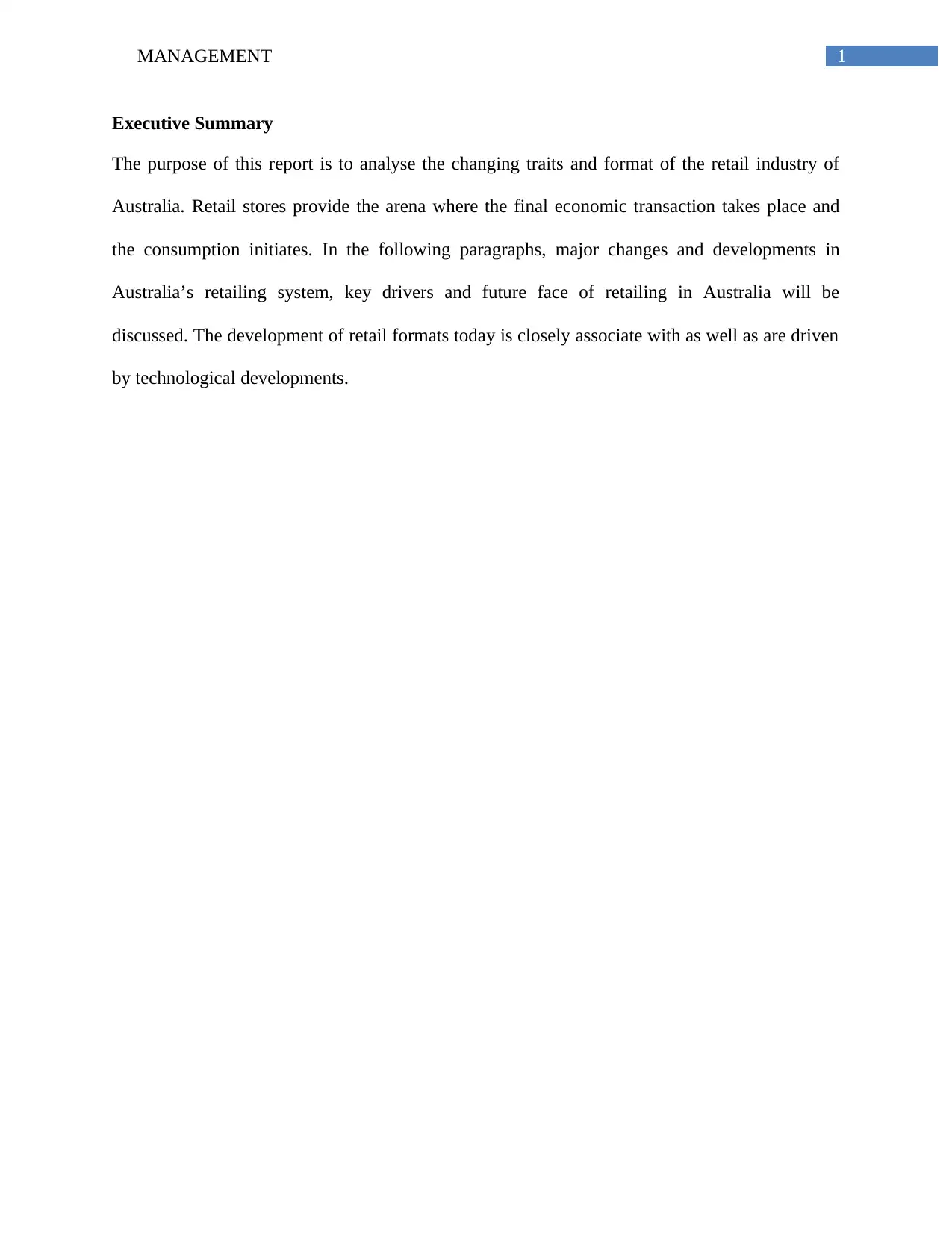
1MANAGEMENT
Executive Summary
The purpose of this report is to analyse the changing traits and format of the retail industry of
Australia. Retail stores provide the arena where the final economic transaction takes place and
the consumption initiates. In the following paragraphs, major changes and developments in
Australia’s retailing system, key drivers and future face of retailing in Australia will be
discussed. The development of retail formats today is closely associate with as well as are driven
by technological developments.
Executive Summary
The purpose of this report is to analyse the changing traits and format of the retail industry of
Australia. Retail stores provide the arena where the final economic transaction takes place and
the consumption initiates. In the following paragraphs, major changes and developments in
Australia’s retailing system, key drivers and future face of retailing in Australia will be
discussed. The development of retail formats today is closely associate with as well as are driven
by technological developments.
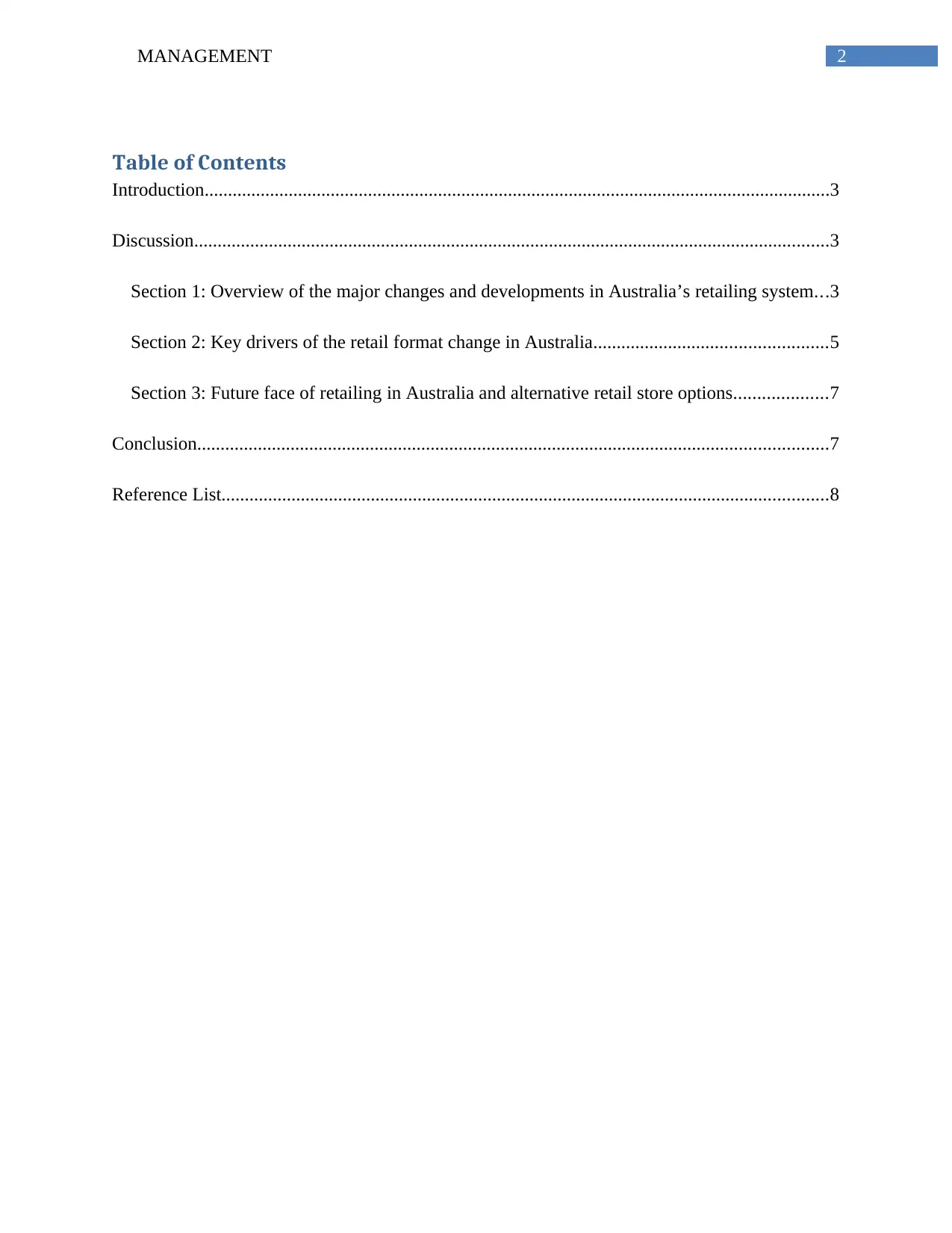
2MANAGEMENT
Table of Contents
Introduction......................................................................................................................................3
Discussion........................................................................................................................................3
Section 1: Overview of the major changes and developments in Australia’s retailing system...3
Section 2: Key drivers of the retail format change in Australia..................................................5
Section 3: Future face of retailing in Australia and alternative retail store options....................7
Conclusion.......................................................................................................................................7
Reference List..................................................................................................................................8
Table of Contents
Introduction......................................................................................................................................3
Discussion........................................................................................................................................3
Section 1: Overview of the major changes and developments in Australia’s retailing system...3
Section 2: Key drivers of the retail format change in Australia..................................................5
Section 3: Future face of retailing in Australia and alternative retail store options....................7
Conclusion.......................................................................................................................................7
Reference List..................................................................................................................................8
⊘ This is a preview!⊘
Do you want full access?
Subscribe today to unlock all pages.

Trusted by 1+ million students worldwide
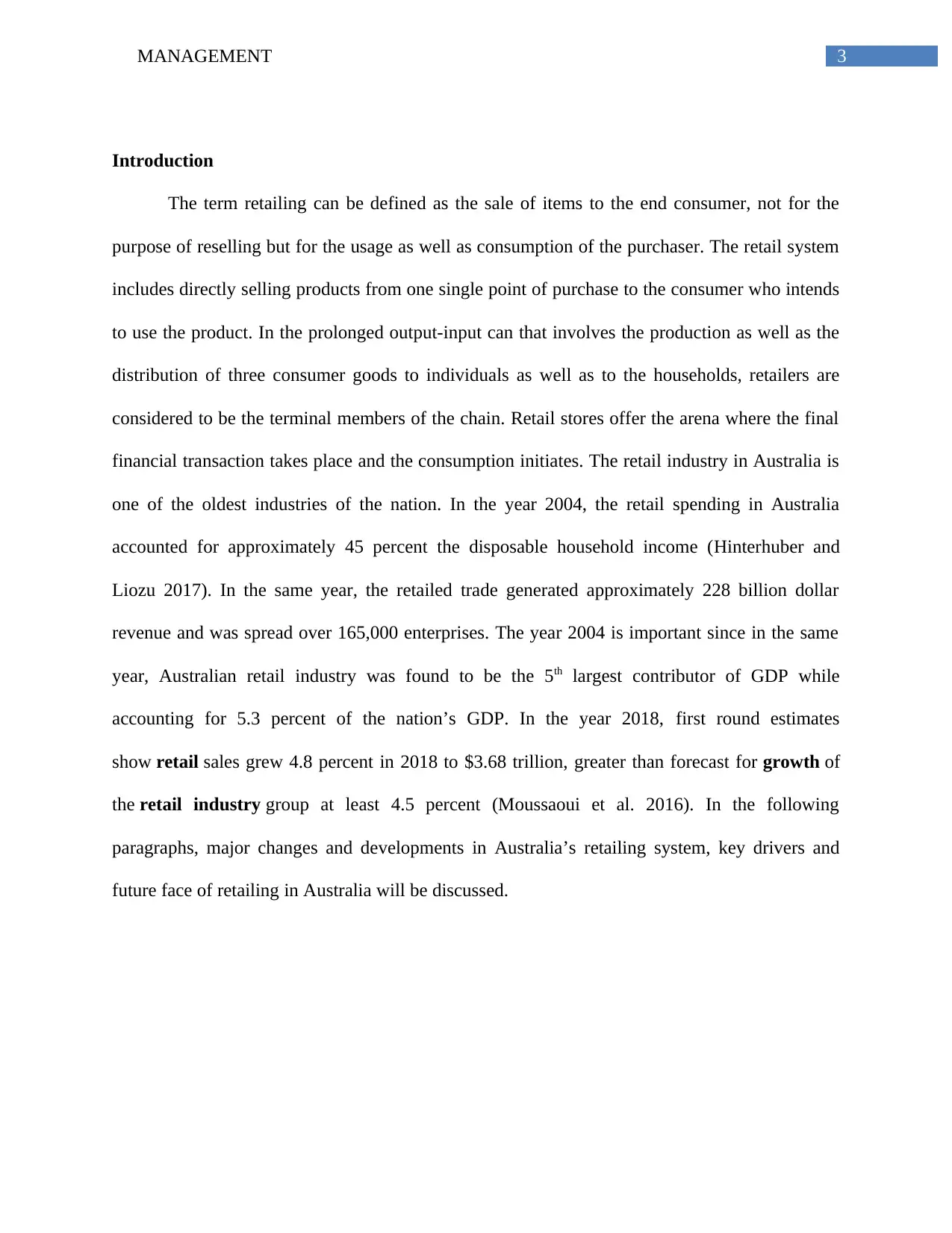
3MANAGEMENT
Introduction
The term retailing can be defined as the sale of items to the end consumer, not for the
purpose of reselling but for the usage as well as consumption of the purchaser. The retail system
includes directly selling products from one single point of purchase to the consumer who intends
to use the product. In the prolonged output-input can that involves the production as well as the
distribution of three consumer goods to individuals as well as to the households, retailers are
considered to be the terminal members of the chain. Retail stores offer the arena where the final
financial transaction takes place and the consumption initiates. The retail industry in Australia is
one of the oldest industries of the nation. In the year 2004, the retail spending in Australia
accounted for approximately 45 percent the disposable household income (Hinterhuber and
Liozu 2017). In the same year, the retailed trade generated approximately 228 billion dollar
revenue and was spread over 165,000 enterprises. The year 2004 is important since in the same
year, Australian retail industry was found to be the 5th largest contributor of GDP while
accounting for 5.3 percent of the nation’s GDP. In the year 2018, first round estimates
show retail sales grew 4.8 percent in 2018 to $3.68 trillion, greater than forecast for growth of
the retail industry group at least 4.5 percent (Moussaoui et al. 2016). In the following
paragraphs, major changes and developments in Australia’s retailing system, key drivers and
future face of retailing in Australia will be discussed.
Introduction
The term retailing can be defined as the sale of items to the end consumer, not for the
purpose of reselling but for the usage as well as consumption of the purchaser. The retail system
includes directly selling products from one single point of purchase to the consumer who intends
to use the product. In the prolonged output-input can that involves the production as well as the
distribution of three consumer goods to individuals as well as to the households, retailers are
considered to be the terminal members of the chain. Retail stores offer the arena where the final
financial transaction takes place and the consumption initiates. The retail industry in Australia is
one of the oldest industries of the nation. In the year 2004, the retail spending in Australia
accounted for approximately 45 percent the disposable household income (Hinterhuber and
Liozu 2017). In the same year, the retailed trade generated approximately 228 billion dollar
revenue and was spread over 165,000 enterprises. The year 2004 is important since in the same
year, Australian retail industry was found to be the 5th largest contributor of GDP while
accounting for 5.3 percent of the nation’s GDP. In the year 2018, first round estimates
show retail sales grew 4.8 percent in 2018 to $3.68 trillion, greater than forecast for growth of
the retail industry group at least 4.5 percent (Moussaoui et al. 2016). In the following
paragraphs, major changes and developments in Australia’s retailing system, key drivers and
future face of retailing in Australia will be discussed.
Paraphrase This Document
Need a fresh take? Get an instant paraphrase of this document with our AI Paraphraser
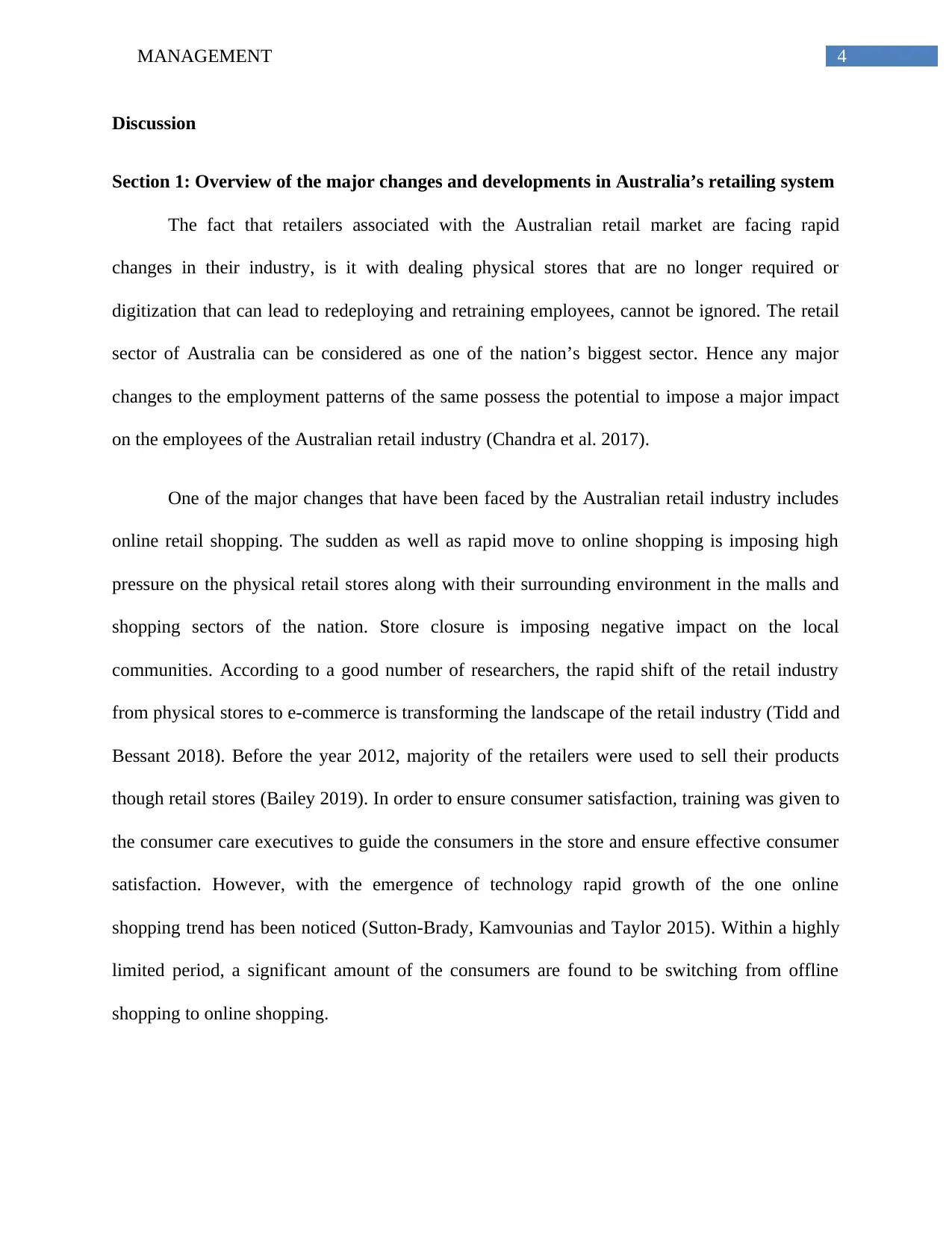
4MANAGEMENT
Discussion
Section 1: Overview of the major changes and developments in Australia’s retailing system
The fact that retailers associated with the Australian retail market are facing rapid
changes in their industry, is it with dealing physical stores that are no longer required or
digitization that can lead to redeploying and retraining employees, cannot be ignored. The retail
sector of Australia can be considered as one of the nation’s biggest sector. Hence any major
changes to the employment patterns of the same possess the potential to impose a major impact
on the employees of the Australian retail industry (Chandra et al. 2017).
One of the major changes that have been faced by the Australian retail industry includes
online retail shopping. The sudden as well as rapid move to online shopping is imposing high
pressure on the physical retail stores along with their surrounding environment in the malls and
shopping sectors of the nation. Store closure is imposing negative impact on the local
communities. According to a good number of researchers, the rapid shift of the retail industry
from physical stores to e-commerce is transforming the landscape of the retail industry (Tidd and
Bessant 2018). Before the year 2012, majority of the retailers were used to sell their products
though retail stores (Bailey 2019). In order to ensure consumer satisfaction, training was given to
the consumer care executives to guide the consumers in the store and ensure effective consumer
satisfaction. However, with the emergence of technology rapid growth of the one online
shopping trend has been noticed (Sutton-Brady, Kamvounias and Taylor 2015). Within a highly
limited period, a significant amount of the consumers are found to be switching from offline
shopping to online shopping.
Discussion
Section 1: Overview of the major changes and developments in Australia’s retailing system
The fact that retailers associated with the Australian retail market are facing rapid
changes in their industry, is it with dealing physical stores that are no longer required or
digitization that can lead to redeploying and retraining employees, cannot be ignored. The retail
sector of Australia can be considered as one of the nation’s biggest sector. Hence any major
changes to the employment patterns of the same possess the potential to impose a major impact
on the employees of the Australian retail industry (Chandra et al. 2017).
One of the major changes that have been faced by the Australian retail industry includes
online retail shopping. The sudden as well as rapid move to online shopping is imposing high
pressure on the physical retail stores along with their surrounding environment in the malls and
shopping sectors of the nation. Store closure is imposing negative impact on the local
communities. According to a good number of researchers, the rapid shift of the retail industry
from physical stores to e-commerce is transforming the landscape of the retail industry (Tidd and
Bessant 2018). Before the year 2012, majority of the retailers were used to sell their products
though retail stores (Bailey 2019). In order to ensure consumer satisfaction, training was given to
the consumer care executives to guide the consumers in the store and ensure effective consumer
satisfaction. However, with the emergence of technology rapid growth of the one online
shopping trend has been noticed (Sutton-Brady, Kamvounias and Taylor 2015). Within a highly
limited period, a significant amount of the consumers are found to be switching from offline
shopping to online shopping.
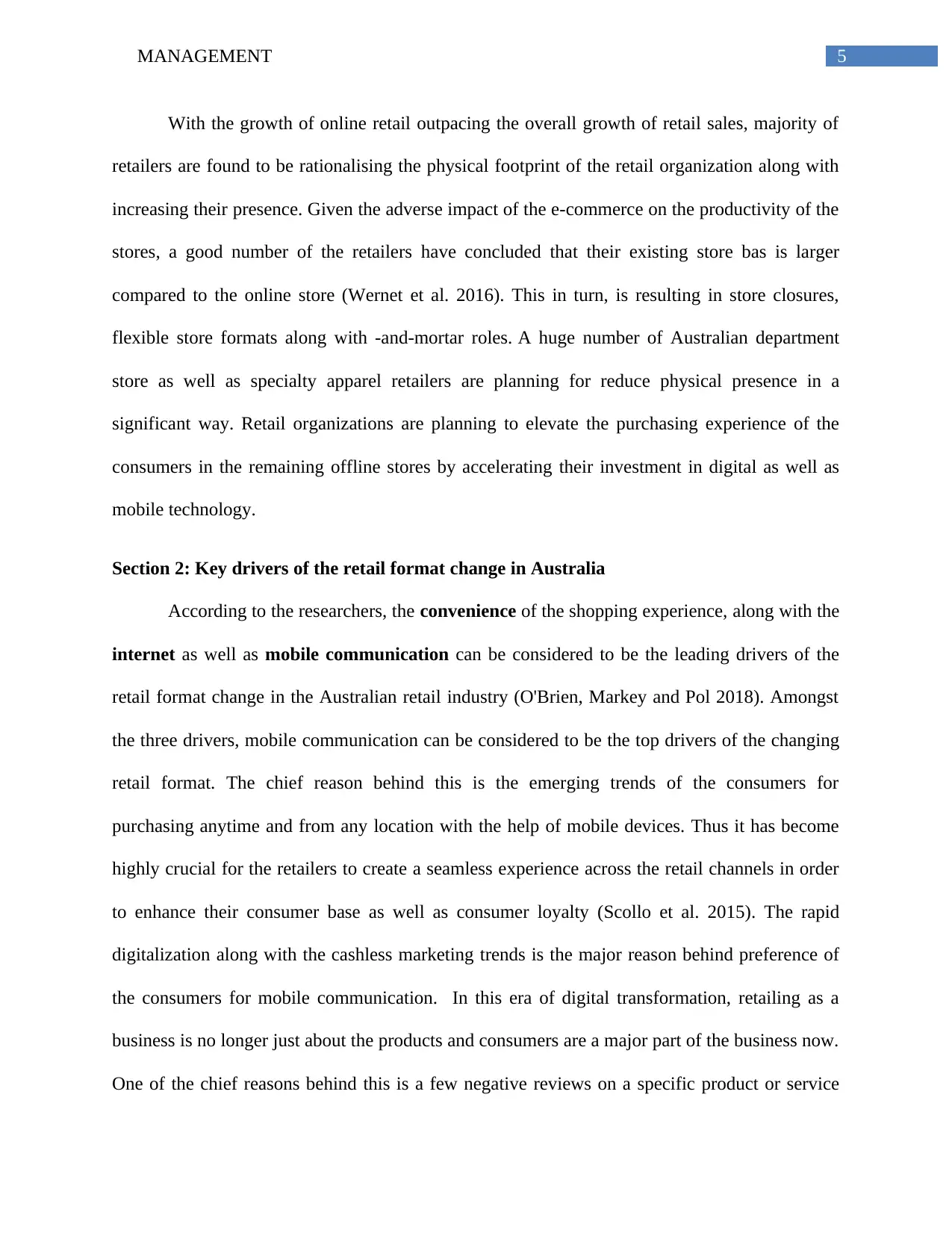
5MANAGEMENT
With the growth of online retail outpacing the overall growth of retail sales, majority of
retailers are found to be rationalising the physical footprint of the retail organization along with
increasing their presence. Given the adverse impact of the e-commerce on the productivity of the
stores, a good number of the retailers have concluded that their existing store bas is larger
compared to the online store (Wernet et al. 2016). This in turn, is resulting in store closures,
flexible store formats along with -and-mortar roles. A huge number of Australian department
store as well as specialty apparel retailers are planning for reduce physical presence in a
significant way. Retail organizations are planning to elevate the purchasing experience of the
consumers in the remaining offline stores by accelerating their investment in digital as well as
mobile technology.
Section 2: Key drivers of the retail format change in Australia
According to the researchers, the convenience of the shopping experience, along with the
internet as well as mobile communication can be considered to be the leading drivers of the
retail format change in the Australian retail industry (O'Brien, Markey and Pol 2018). Amongst
the three drivers, mobile communication can be considered to be the top drivers of the changing
retail format. The chief reason behind this is the emerging trends of the consumers for
purchasing anytime and from any location with the help of mobile devices. Thus it has become
highly crucial for the retailers to create a seamless experience across the retail channels in order
to enhance their consumer base as well as consumer loyalty (Scollo et al. 2015). The rapid
digitalization along with the cashless marketing trends is the major reason behind preference of
the consumers for mobile communication. In this era of digital transformation, retailing as a
business is no longer just about the products and consumers are a major part of the business now.
One of the chief reasons behind this is a few negative reviews on a specific product or service
With the growth of online retail outpacing the overall growth of retail sales, majority of
retailers are found to be rationalising the physical footprint of the retail organization along with
increasing their presence. Given the adverse impact of the e-commerce on the productivity of the
stores, a good number of the retailers have concluded that their existing store bas is larger
compared to the online store (Wernet et al. 2016). This in turn, is resulting in store closures,
flexible store formats along with -and-mortar roles. A huge number of Australian department
store as well as specialty apparel retailers are planning for reduce physical presence in a
significant way. Retail organizations are planning to elevate the purchasing experience of the
consumers in the remaining offline stores by accelerating their investment in digital as well as
mobile technology.
Section 2: Key drivers of the retail format change in Australia
According to the researchers, the convenience of the shopping experience, along with the
internet as well as mobile communication can be considered to be the leading drivers of the
retail format change in the Australian retail industry (O'Brien, Markey and Pol 2018). Amongst
the three drivers, mobile communication can be considered to be the top drivers of the changing
retail format. The chief reason behind this is the emerging trends of the consumers for
purchasing anytime and from any location with the help of mobile devices. Thus it has become
highly crucial for the retailers to create a seamless experience across the retail channels in order
to enhance their consumer base as well as consumer loyalty (Scollo et al. 2015). The rapid
digitalization along with the cashless marketing trends is the major reason behind preference of
the consumers for mobile communication. In this era of digital transformation, retailing as a
business is no longer just about the products and consumers are a major part of the business now.
One of the chief reasons behind this is a few negative reviews on a specific product or service
⊘ This is a preview!⊘
Do you want full access?
Subscribe today to unlock all pages.

Trusted by 1+ million students worldwide
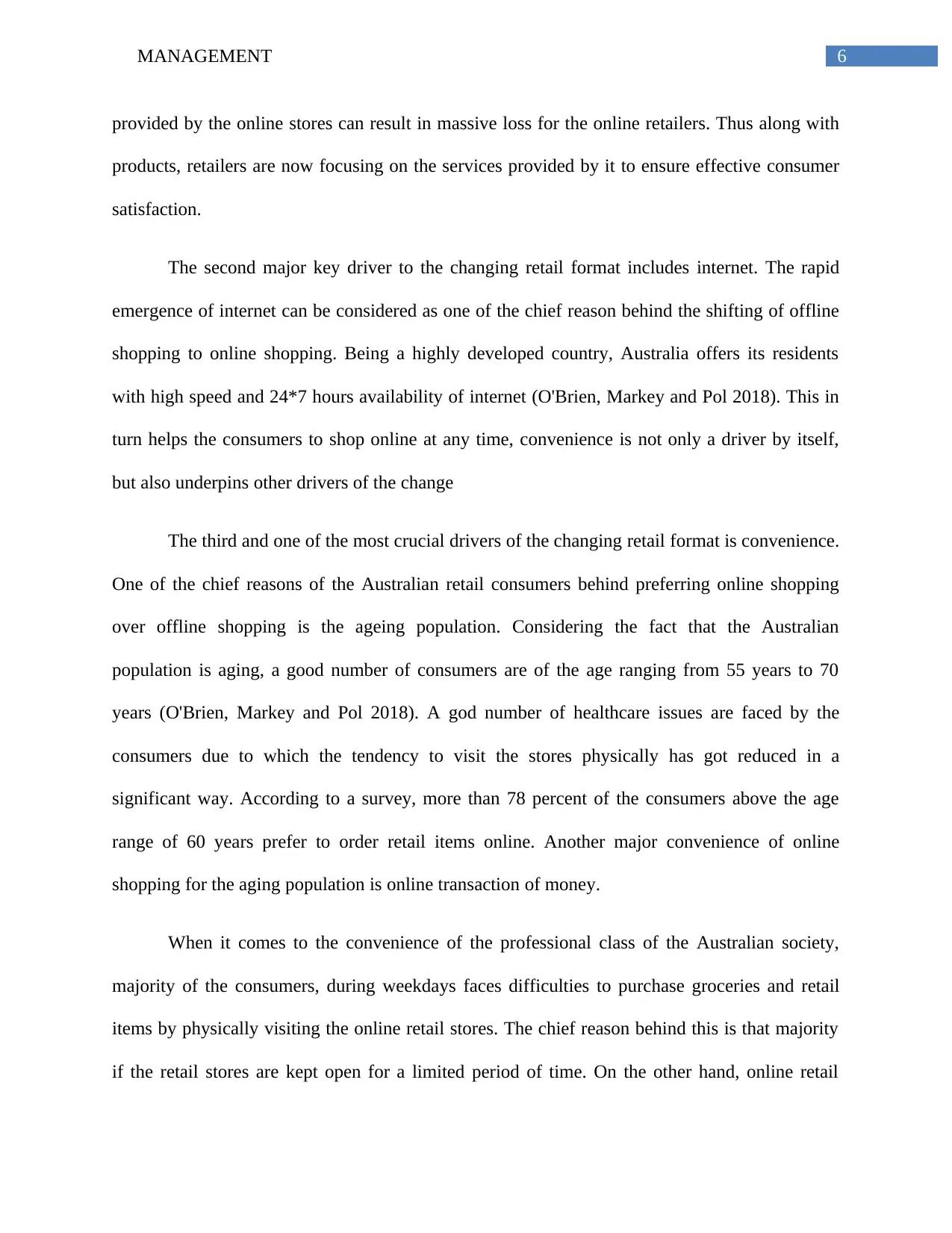
6MANAGEMENT
provided by the online stores can result in massive loss for the online retailers. Thus along with
products, retailers are now focusing on the services provided by it to ensure effective consumer
satisfaction.
The second major key driver to the changing retail format includes internet. The rapid
emergence of internet can be considered as one of the chief reason behind the shifting of offline
shopping to online shopping. Being a highly developed country, Australia offers its residents
with high speed and 24*7 hours availability of internet (O'Brien, Markey and Pol 2018). This in
turn helps the consumers to shop online at any time, convenience is not only a driver by itself,
but also underpins other drivers of the change
The third and one of the most crucial drivers of the changing retail format is convenience.
One of the chief reasons of the Australian retail consumers behind preferring online shopping
over offline shopping is the ageing population. Considering the fact that the Australian
population is aging, a good number of consumers are of the age ranging from 55 years to 70
years (O'Brien, Markey and Pol 2018). A god number of healthcare issues are faced by the
consumers due to which the tendency to visit the stores physically has got reduced in a
significant way. According to a survey, more than 78 percent of the consumers above the age
range of 60 years prefer to order retail items online. Another major convenience of online
shopping for the aging population is online transaction of money.
When it comes to the convenience of the professional class of the Australian society,
majority of the consumers, during weekdays faces difficulties to purchase groceries and retail
items by physically visiting the online retail stores. The chief reason behind this is that majority
if the retail stores are kept open for a limited period of time. On the other hand, online retail
provided by the online stores can result in massive loss for the online retailers. Thus along with
products, retailers are now focusing on the services provided by it to ensure effective consumer
satisfaction.
The second major key driver to the changing retail format includes internet. The rapid
emergence of internet can be considered as one of the chief reason behind the shifting of offline
shopping to online shopping. Being a highly developed country, Australia offers its residents
with high speed and 24*7 hours availability of internet (O'Brien, Markey and Pol 2018). This in
turn helps the consumers to shop online at any time, convenience is not only a driver by itself,
but also underpins other drivers of the change
The third and one of the most crucial drivers of the changing retail format is convenience.
One of the chief reasons of the Australian retail consumers behind preferring online shopping
over offline shopping is the ageing population. Considering the fact that the Australian
population is aging, a good number of consumers are of the age ranging from 55 years to 70
years (O'Brien, Markey and Pol 2018). A god number of healthcare issues are faced by the
consumers due to which the tendency to visit the stores physically has got reduced in a
significant way. According to a survey, more than 78 percent of the consumers above the age
range of 60 years prefer to order retail items online. Another major convenience of online
shopping for the aging population is online transaction of money.
When it comes to the convenience of the professional class of the Australian society,
majority of the consumers, during weekdays faces difficulties to purchase groceries and retail
items by physically visiting the online retail stores. The chief reason behind this is that majority
if the retail stores are kept open for a limited period of time. On the other hand, online retail
Paraphrase This Document
Need a fresh take? Get an instant paraphrase of this document with our AI Paraphraser
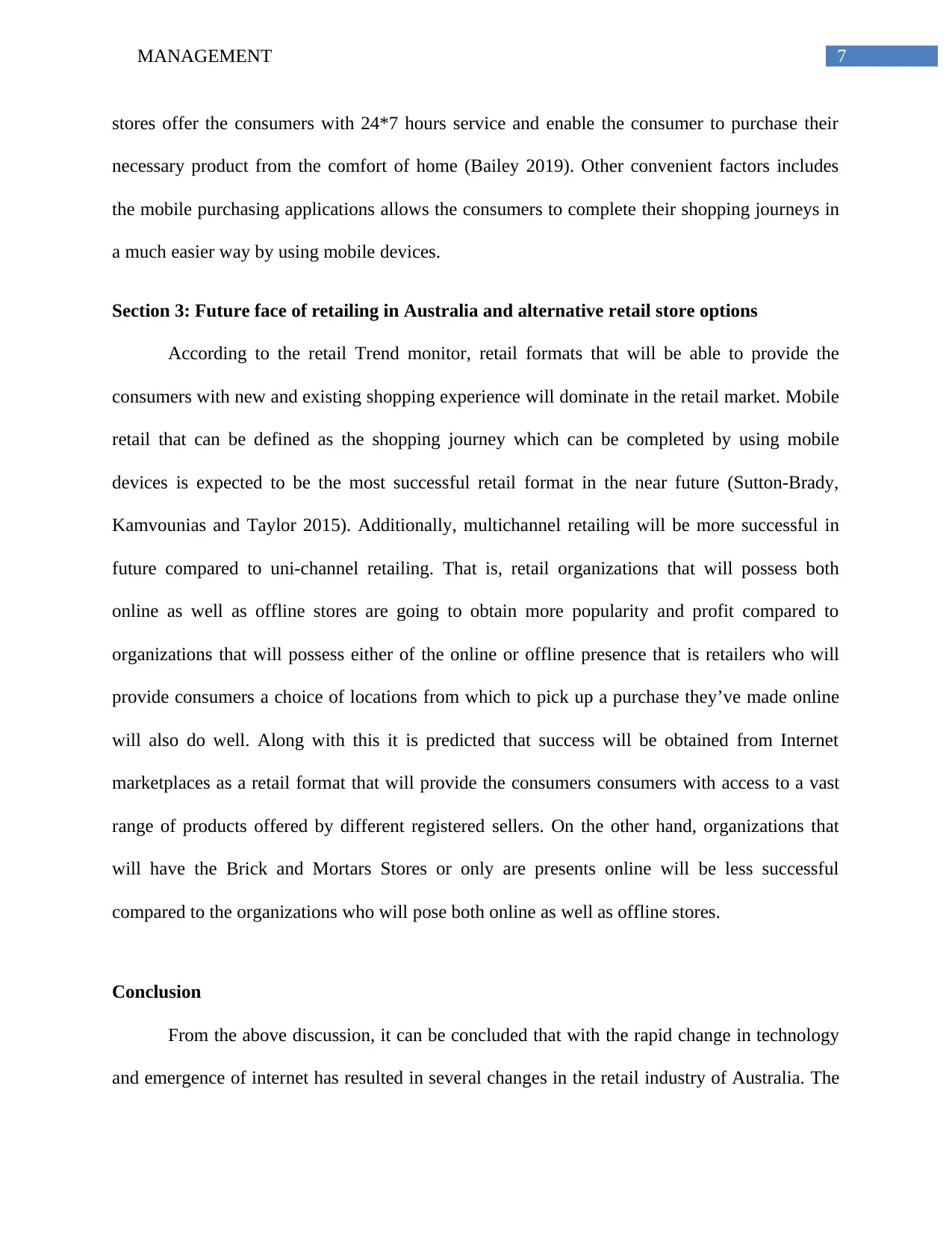
7MANAGEMENT
stores offer the consumers with 24*7 hours service and enable the consumer to purchase their
necessary product from the comfort of home (Bailey 2019). Other convenient factors includes
the mobile purchasing applications allows the consumers to complete their shopping journeys in
a much easier way by using mobile devices.
Section 3: Future face of retailing in Australia and alternative retail store options
According to the retail Trend monitor, retail formats that will be able to provide the
consumers with new and existing shopping experience will dominate in the retail market. Mobile
retail that can be defined as the shopping journey which can be completed by using mobile
devices is expected to be the most successful retail format in the near future (Sutton-Brady,
Kamvounias and Taylor 2015). Additionally, multichannel retailing will be more successful in
future compared to uni-channel retailing. That is, retail organizations that will possess both
online as well as offline stores are going to obtain more popularity and profit compared to
organizations that will possess either of the online or offline presence that is retailers who will
provide consumers a choice of locations from which to pick up a purchase they’ve made online
will also do well. Along with this it is predicted that success will be obtained from Internet
marketplaces as a retail format that will provide the consumers consumers with access to a vast
range of products offered by different registered sellers. On the other hand, organizations that
will have the Brick and Mortars Stores or only are presents online will be less successful
compared to the organizations who will pose both online as well as offline stores.
Conclusion
From the above discussion, it can be concluded that with the rapid change in technology
and emergence of internet has resulted in several changes in the retail industry of Australia. The
stores offer the consumers with 24*7 hours service and enable the consumer to purchase their
necessary product from the comfort of home (Bailey 2019). Other convenient factors includes
the mobile purchasing applications allows the consumers to complete their shopping journeys in
a much easier way by using mobile devices.
Section 3: Future face of retailing in Australia and alternative retail store options
According to the retail Trend monitor, retail formats that will be able to provide the
consumers with new and existing shopping experience will dominate in the retail market. Mobile
retail that can be defined as the shopping journey which can be completed by using mobile
devices is expected to be the most successful retail format in the near future (Sutton-Brady,
Kamvounias and Taylor 2015). Additionally, multichannel retailing will be more successful in
future compared to uni-channel retailing. That is, retail organizations that will possess both
online as well as offline stores are going to obtain more popularity and profit compared to
organizations that will possess either of the online or offline presence that is retailers who will
provide consumers a choice of locations from which to pick up a purchase they’ve made online
will also do well. Along with this it is predicted that success will be obtained from Internet
marketplaces as a retail format that will provide the consumers consumers with access to a vast
range of products offered by different registered sellers. On the other hand, organizations that
will have the Brick and Mortars Stores or only are presents online will be less successful
compared to the organizations who will pose both online as well as offline stores.
Conclusion
From the above discussion, it can be concluded that with the rapid change in technology
and emergence of internet has resulted in several changes in the retail industry of Australia. The
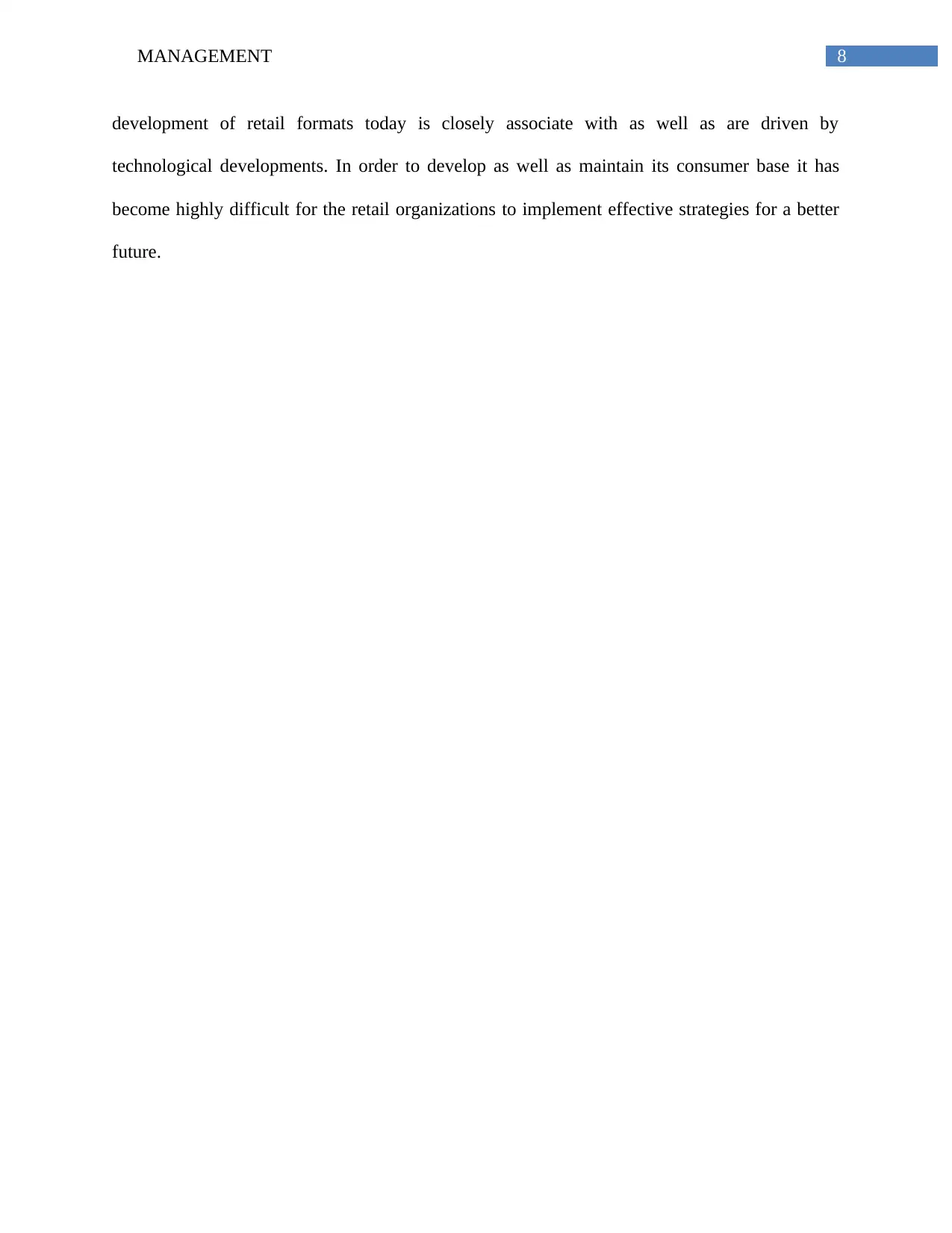
8MANAGEMENT
development of retail formats today is closely associate with as well as are driven by
technological developments. In order to develop as well as maintain its consumer base it has
become highly difficult for the retail organizations to implement effective strategies for a better
future.
development of retail formats today is closely associate with as well as are driven by
technological developments. In order to develop as well as maintain its consumer base it has
become highly difficult for the retail organizations to implement effective strategies for a better
future.
⊘ This is a preview!⊘
Do you want full access?
Subscribe today to unlock all pages.

Trusted by 1+ million students worldwide
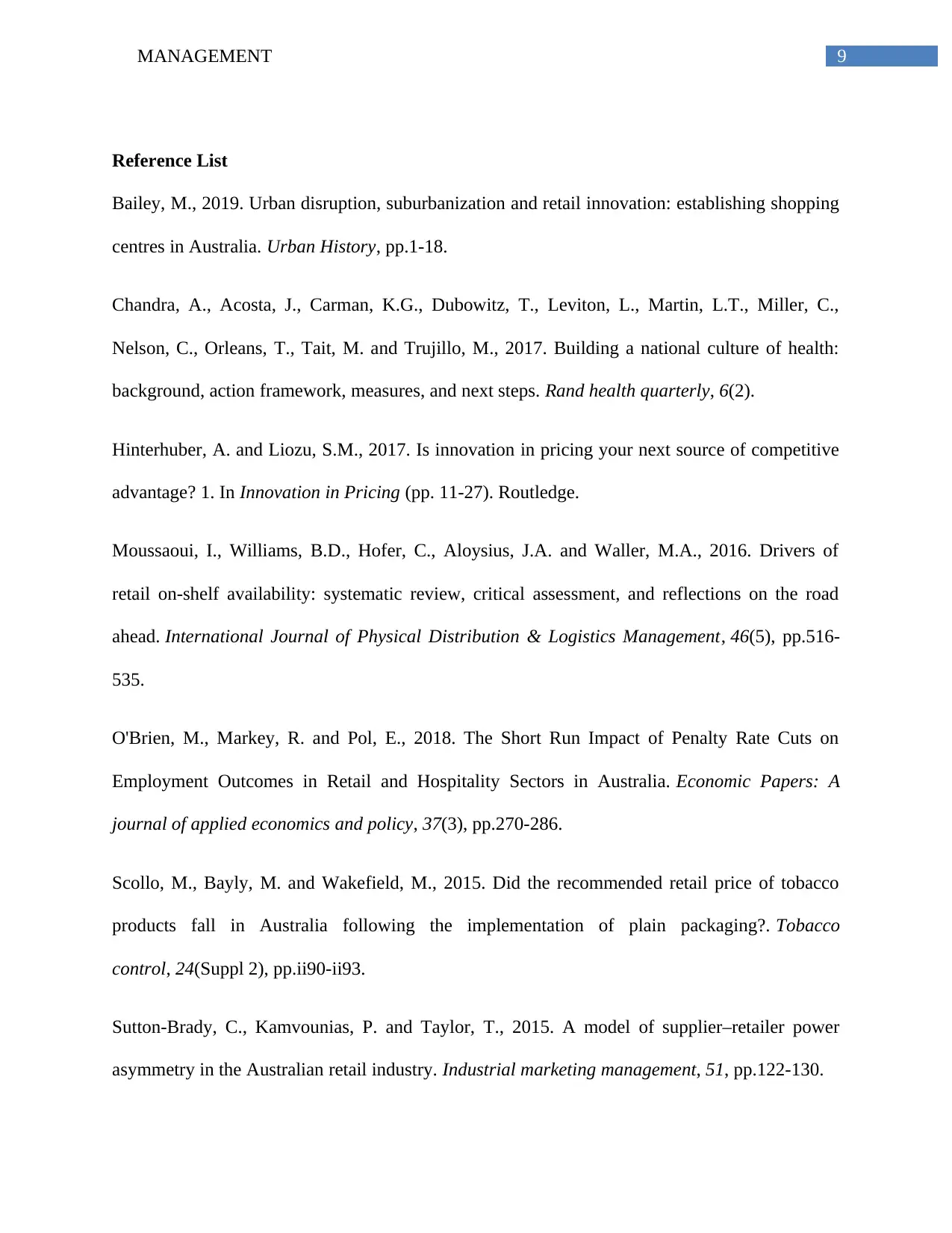
9MANAGEMENT
Reference List
Bailey, M., 2019. Urban disruption, suburbanization and retail innovation: establishing shopping
centres in Australia. Urban History, pp.1-18.
Chandra, A., Acosta, J., Carman, K.G., Dubowitz, T., Leviton, L., Martin, L.T., Miller, C.,
Nelson, C., Orleans, T., Tait, M. and Trujillo, M., 2017. Building a national culture of health:
background, action framework, measures, and next steps. Rand health quarterly, 6(2).
Hinterhuber, A. and Liozu, S.M., 2017. Is innovation in pricing your next source of competitive
advantage? 1. In Innovation in Pricing (pp. 11-27). Routledge.
Moussaoui, I., Williams, B.D., Hofer, C., Aloysius, J.A. and Waller, M.A., 2016. Drivers of
retail on-shelf availability: systematic review, critical assessment, and reflections on the road
ahead. International Journal of Physical Distribution & Logistics Management, 46(5), pp.516-
535.
O'Brien, M., Markey, R. and Pol, E., 2018. The Short Run Impact of Penalty Rate Cuts on
Employment Outcomes in Retail and Hospitality Sectors in Australia. Economic Papers: A
journal of applied economics and policy, 37(3), pp.270-286.
Scollo, M., Bayly, M. and Wakefield, M., 2015. Did the recommended retail price of tobacco
products fall in Australia following the implementation of plain packaging?. Tobacco
control, 24(Suppl 2), pp.ii90-ii93.
Sutton-Brady, C., Kamvounias, P. and Taylor, T., 2015. A model of supplier–retailer power
asymmetry in the Australian retail industry. Industrial marketing management, 51, pp.122-130.
Reference List
Bailey, M., 2019. Urban disruption, suburbanization and retail innovation: establishing shopping
centres in Australia. Urban History, pp.1-18.
Chandra, A., Acosta, J., Carman, K.G., Dubowitz, T., Leviton, L., Martin, L.T., Miller, C.,
Nelson, C., Orleans, T., Tait, M. and Trujillo, M., 2017. Building a national culture of health:
background, action framework, measures, and next steps. Rand health quarterly, 6(2).
Hinterhuber, A. and Liozu, S.M., 2017. Is innovation in pricing your next source of competitive
advantage? 1. In Innovation in Pricing (pp. 11-27). Routledge.
Moussaoui, I., Williams, B.D., Hofer, C., Aloysius, J.A. and Waller, M.A., 2016. Drivers of
retail on-shelf availability: systematic review, critical assessment, and reflections on the road
ahead. International Journal of Physical Distribution & Logistics Management, 46(5), pp.516-
535.
O'Brien, M., Markey, R. and Pol, E., 2018. The Short Run Impact of Penalty Rate Cuts on
Employment Outcomes in Retail and Hospitality Sectors in Australia. Economic Papers: A
journal of applied economics and policy, 37(3), pp.270-286.
Scollo, M., Bayly, M. and Wakefield, M., 2015. Did the recommended retail price of tobacco
products fall in Australia following the implementation of plain packaging?. Tobacco
control, 24(Suppl 2), pp.ii90-ii93.
Sutton-Brady, C., Kamvounias, P. and Taylor, T., 2015. A model of supplier–retailer power
asymmetry in the Australian retail industry. Industrial marketing management, 51, pp.122-130.
Paraphrase This Document
Need a fresh take? Get an instant paraphrase of this document with our AI Paraphraser
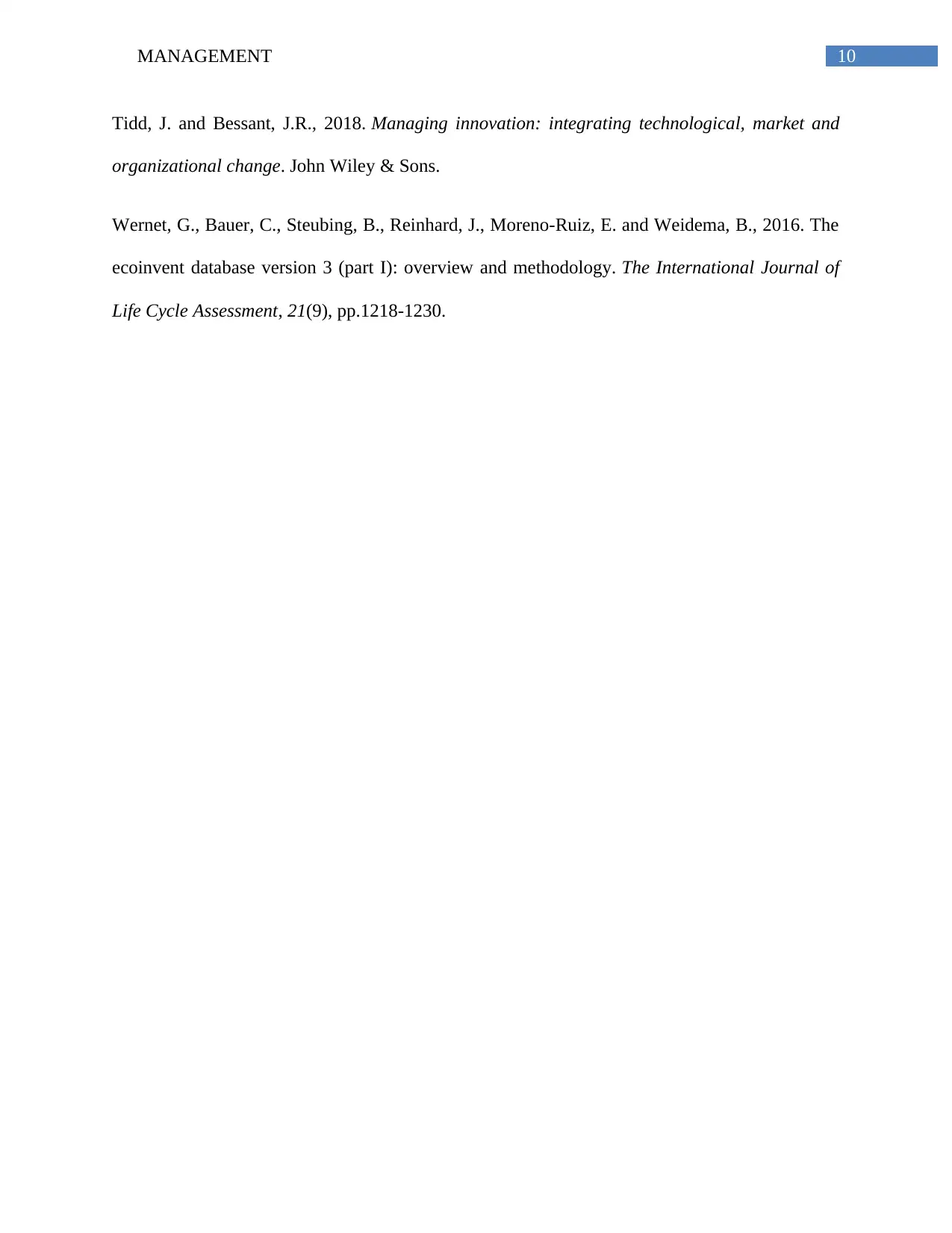
10MANAGEMENT
Tidd, J. and Bessant, J.R., 2018. Managing innovation: integrating technological, market and
organizational change. John Wiley & Sons.
Wernet, G., Bauer, C., Steubing, B., Reinhard, J., Moreno-Ruiz, E. and Weidema, B., 2016. The
ecoinvent database version 3 (part I): overview and methodology. The International Journal of
Life Cycle Assessment, 21(9), pp.1218-1230.
Tidd, J. and Bessant, J.R., 2018. Managing innovation: integrating technological, market and
organizational change. John Wiley & Sons.
Wernet, G., Bauer, C., Steubing, B., Reinhard, J., Moreno-Ruiz, E. and Weidema, B., 2016. The
ecoinvent database version 3 (part I): overview and methodology. The International Journal of
Life Cycle Assessment, 21(9), pp.1218-1230.
1 out of 11
Related Documents
Your All-in-One AI-Powered Toolkit for Academic Success.
+13062052269
info@desklib.com
Available 24*7 on WhatsApp / Email
![[object Object]](/_next/static/media/star-bottom.7253800d.svg)
Unlock your academic potential
Copyright © 2020–2025 A2Z Services. All Rights Reserved. Developed and managed by ZUCOL.





